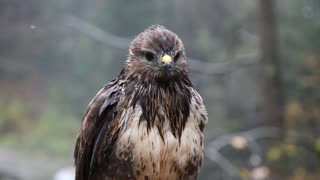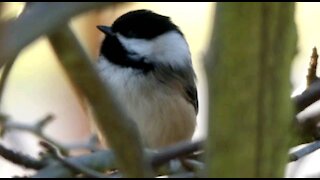Grey Hawk Bird Sound, Bird Song, Bird Call, Bird Calling Chirps, Lissen Birds Chirping Melody Songs
gray hawk (Buteo plagiatus) or Mexican goshawk is a smallish raptor found in open country and forest edges. It is sometimes placed in the genus Asturina as Asturina plagiata. The species was split by the American Ornithological Society (AOU) from the gray-lined hawk. The gray hawk is found from Costa Rica north into the southwestern United States.
The gray hawk is 46–61 cm (18–24 in) in length and weighs 475 g (16.8 oz) on average. The adult has a pale gray body, the tail is black with three white bands and the legs are orange. It is a solid, unpatterned gray on the upper parts.
Immature birds have dark brown upperparts, a pale-banded brown tail, brown-spotted white underparts and a brown streaked buff head and neck. This species is quite short-winged, and has a fast agile flight for a Buteo. The call is a shrill whistled kleee-ooo.
Gray hawks feed mainly on lizards and snakes, but will also take small mammals, birds and frogs. It usually sits on an open high perch from which it swoops on its prey, but will also hunt from a low glide. The nest is of sticks and built high in a tree. The usual clutch is one to three, usually two white to pale blue eggs. The young take about 6 weeks to fledging.
The gray hawk averages 46–61 cm (18–24 in) inches in length and weighs 475 g (16.8 oz). This bird has a relatively short wing span, but long tail compared to the red-tailed and red-shouldered hawks. It has broad rounded wings, a hooked beak, and yellow legs. Thompson, L. (1995–2013). It is very distinctive from its smooth pale gray plumage. The tail features are in a horizontal stripped pattern in a white gray white pattern with white at the tips of the tail feathers. The tail feathers have two white bands with one being wider than the other. The sexes are similar in coloration. The adults, both male and female, have a darker gray top side with a lighter gray and white underside. The juveniles have a dark brown topside and a streaked or spotted underside and the tail feathers have numerous dark bands. The juveniles have very obvious bold facial strips and white upper tail coverts, which are the feathers at the base or start of the tail. The juveniles also have a different plumage color due to dominance and they use the dull color for camouflage. The taxonomy of the gray hawk puts it within in the genus Buteo. This genus consists of hawks, which include the red-shouldered hawk, Swainson's hawk, and others. The genus Buteo is in the sub-family Accipitrinae which is also known as the "true hawks", and Accipitrinae is within the family of Accipitridae. Accipitridae consist of hawks, old world vultures, kites, harriers, and eagles. This family is within the order Falconiformes which are the diurnal (active during the day) birds of prey.
The species was originally described by Hermann Schlegel in 1862 as Asturina plagiata. The AOU listed A. plagiata with the common name "Mexican goshawk" in the first four editions of the Check-List of North American Birds, from 1886–1931. By the 1957 fifth edition, it had been merged into Buteo nitidis; but by the 1998 seventh edition all of B. nitidis was separated into the resurrected genus Asturina.
In 2003, Riesing et al. published results of research on nucleotide sequences within the mitochondrial nd6 gene and pseudo-control-region for all species of Buteo and several related species. Among other findings, they recommended that Asturina be merged into Buteo, and concluded that A. nitidis plagiatus was sufficiently different from A. n. nitidis and A. n. costaricensis to be considered a separate species. In 2005, the AOC's Committee on Classification and Nomenclature – North America decided to follow the recommendation to merge the genera, but was not convinced about splitting the species.
The gray hawk was originally Asturina nitida but controversy existed between ornithologists on whether or not this species was closely enough related enough to put it in the Buteo, but chromosomal mapping in 2013 has proved that the gray hawk is within the Buteoninae. Researchers such as de Oliveira, T
-
 0:24
0:24
misunderstoodhaiku
3 years agoCat calling the birds
38 -
 0:16
0:16
catalin03
3 years agoRain and birds chill sound
11 -
 0:10
0:10
Nature Lovers
3 years agoBirds Falcon Fauna Bird Bird Of Prey
441 -
 0:26
0:26
KonstantinBeluga
3 years agoCute Chickadee bird chirping and stretching.
90 -
 0:35
0:35
LifeWithBobbie
3 years ago $0.01 earnedBirds at the bird feeder
481 -
 55:04
55:04
Matt Kohrs
9 hours agoThe Volatile Week Ahead || The MK Show
42.6K18 -
 26:18
26:18
Stephen Gardner
8 hours agoTop Republican UNLOADS on Democrats and Biden's MENTAL HEALTH!!
54.2K97 -
 44:30
44:30
Michael Franzese
2 days agoCancel Culture Backlash of My UK Tour | Michael Franzese
114K45 -
 35:12
35:12
Island Hopper TV
1 day agoFull Costa Rica Travel Guide 2024
76.4K33 -
 4:43
4:43
ParisDemers
1 day agoThis Diet Hack Changed My Life! (How To Get Ripped FAST!)
86K30